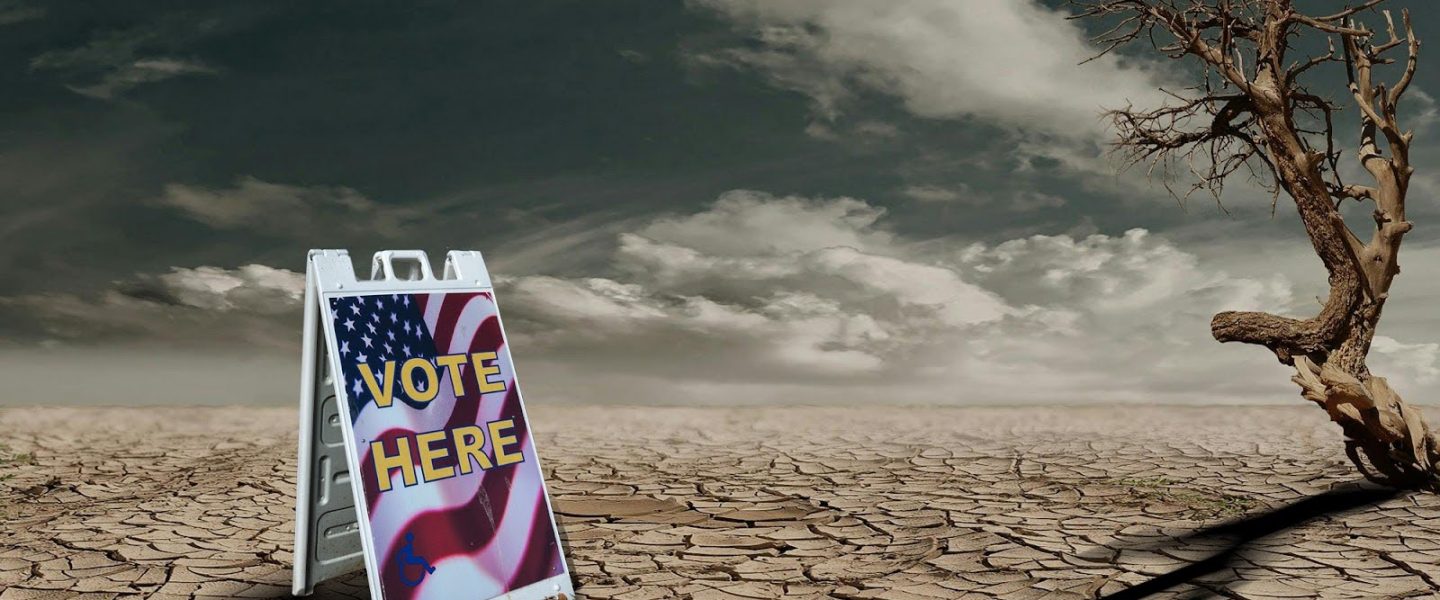From Biden vs. Trump to an oil well referendum in California, climate change debate is all over the ballot in federal, state, and local contests.
|
Listen To This Story
|
In the wake of the hottest year on record, with fossil fuel production increasing and sea levels rising, the stakes for the climate couldn’t be higher in this year’s elections.
In the presidential contest, the contrast is distinct. President Joe Biden’s massive climate initiatives and tougher environmental regulations are sure to drive turnout on both sides of the political aisle. And likely Republican nominee Donald Trump’s promises to pull the country out of the Paris Climate Accords again, aggressively “drill baby drill,” and repeal the Inflation Reduction Act are making headlines.
In previous election cycles, climate change was typically low on the list of voters’ concerns and largely ignored by the candidates. But it was a powerful predictor of voters’ behavior — helping boost Democrats in recent elections, according to a new study. Climate change likely cost Republicans the 2020 election, according to researchers at the University of Colorado Boulder Center for Environmental Futures, helping pull Democrats, independents, moderate Republicans, and younger voters to the polls.
The differences between the parties have grown even more stark in recent years. Back in 2008, then-Democratic Speaker of the House Nancy Pelosi and former Republican Speaker Newt Gingrich sat on a couch outside the US Capitol for a TV ad. “We don’t always see eye to eye,” Pelosi said, to which Gingrich replied, “But we do agree our country must take action to address climate change.”
Times have changed. Now, according to a recent Pew Research Center poll, 78 percent of Democrats view climate change as a major threat, compared to only 23 percent of Republicans.
Nathaniel Stinnett, founder of the Environmental Voter Project, is hopeful those numbers will play out on the campaign trail. “The question is: Will that lead to climate debates in the elections, more and more climate messaging from the campaign?”
Stinnett’s group is overwhelmingly targeting young voters, one of the few demographics for whom climate has been an overriding issue.
“Climate action is going to be a top issue for young voters given that we are inheriting a world that has been ravaged by greedy companies and worsening weather disasters,” said Jack Lobel, a Columbia University student and spokesperson for Voters of Tomorrow, which seeks to mobilize young voters.
The second-most climate-concerned age demographic is at the other end of the spectrum — older people, many of whom have seen the effects of climate change during their lifetimes and who have decades of experience with activism. Older people, who vote in greater numbers than young people, are three times as likely to list climate as a top priority than middle-aged people, Stinnett said.
The Biden administration has now gone on the offensive. At a Jan. 30 reception in Jupiter, Florida, the president told supporters: “We’re saving the planet with the most significant investment in climate change ever anywhere in the history of the world — literally anywhere.” He added a dark warning: “Now imagine the nightmare if Trump is returned to office.”
There might be cause for such dramatic language. Biden’s climate agenda is a key target of conservative activists, including those at The Heritage Foundation, which recently released a 900-page blueprint titled “Project 2025” for a future Trump administration. Among its proposals: Reduce the role of the US Global Change Research Program, the decades-old initiative that first alerted the world to the depletion of the ozone layer in the 1990s, and replace the White House climate adviser with an energy/environment adviser who would coordinate policy with the oil and gas industry.
Fossil fuel producers and renewable energy interests alike are spending millions in campaign contributions and ad campaigns to influence voters. Oil and gas interests contributed at least $8.3 million to Trump’s reelection in the last half of 2023, while the country’s biggest fossil fuel industry group, the American Petroleum Institute, is launching an eight-figure ad campaign to urge voters to dismantle much of Biden’s climate agenda.
Meanwhile, the advocacy group Climate Power has vowed to spend $80 million to promote Biden’s climate policy and clean energy accomplishments, while the Holdfast Collective, a group of nonprofit groups created and funded by outdoor apparel company Patagonia, has already doled out around $71 million to climate-focused causes
While the presidential contest is sucking up most of the oxygen, there are other federal races that will have an effect on climate policy.
In Arizona, US Senate candidate Kari Lake, the MAGA celebrity who lost the 2022 gubernatorial race, has dismissed concerns about climate change. Last summer, when a brutal record-breaking heat wave devastated the state, her campaign accused Democratic Gov. Katie Hobbs and Democratic Senate contender Ruben Gallego of “pushing mass hysteria in an effort to declare a climate emergency” and blamed heat-related deaths on “the meth their policies allow to flow freely on our streets.”
The state’s current senator, Kyrsten Sinema, an independent who has not declared whether she will seek reelection, supported Biden’s climate initiatives but has angered environmentalists with some industry-friendly stances, such as easing requirements for renewable energy sources to plug into the electrical grid.
In Montana, where climate change has reduced agricultural yields and increased wildfires, Democratic Sen. Jon Tester, one of the Senate’s only working farmers, was called an “unlikely champion for climate action” by The Washington Post because of his support for efforts to reduce fossil fuel emissions and speed up the transition to clean energy. His likely Republican opponent, businessman and combat veteran Tim Sheehy, has expressed support for international efforts to combat climate change but has changed his tune since launching his campaign — telling Fox News that “the cleanest form of energy known to man is American fossil fuels” and removing climate change references from his company’s website.
Even in red states, climate change is driving candidates. In Utah, a traditional GOP stronghold, Republican US Rep. John Curtis is running for the Senate seat being vacated by Mitt Romney with a strong climate agenda. The founder of the House of Representatives’ Conservative Climate Caucus, Curtis is an outlier in his party, taking global warming seriously and saying that it’s partly the GOP’s “fault that climate change is so politically polarized.” On the Democratic side, one of the leading contenders is climate activist and mountain climber Caroline Gleich, a social media celebrity who plans to focus on “social and environmental justice.”
Beyond the headline-making races, there are consequential elections in state legislatures and local communities that will affect policy in some of the highest-climate-risk states, such as Florida, South Carolina, Georgia, and Texas, where voters are affected by local climate issues, such as what energy sources they use, how energy efficient their buildings are, and what protection they have against wildfires or floods.
In states such as California, there are climate-related referendums on the ballot. When California passed a law mandating setbacks between oil wells and local communities, the petroleum industry and its political allies spent more than $20 million to put a referendum on the November ballot that could gut the law. The outcome of this expensive battle — the Campaign for a Safe and Healthy California is raising $2.3 million to keep the law — could have repercussions for decades to come.
We can not predict the outcome of the fall elections, but there is no doubt among scientists that immediate and transformative action is our only hope against a future of cataclysmic weather, mass migration, and wars caused by our destabilized environment. As time runs out, it is candidates and voters who will determine if we step up to the challenge.
This story by Marcus Baram was originally published by Capital & Main and is part of Covering Climate Now, a global journalism collaboration strengthening coverage of the climate story.





